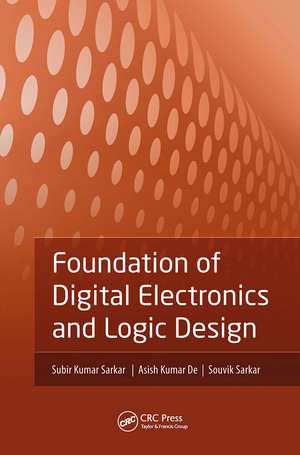Foundation of Digital Electronics and Logic Design
Autor Subir Kumar Sarkar, Asish Kumar De, Souvik Sarkaren Limba Engleză Hardback – 10 dec 2014
Preț: 681.89 lei
Preț vechi: 852.37 lei
-20% Nou
Puncte Express: 1023
Preț estimativ în valută:
130.50€ • 135.74$ • 107.73£
130.50€ • 135.74$ • 107.73£
Carte tipărită la comandă
Livrare economică 14-28 aprilie
Preluare comenzi: 021 569.72.76
Specificații
ISBN-13: 9789814364584
ISBN-10: 9814364584
Pagini: 380
Ilustrații: 338 black & white illustrations
Dimensiuni: 152 x 229 x 25 mm
Greutate: 0.64 kg
Ediția:1
Editura: Jenny Stanford Publishing
Colecția Jenny Stanford Publishing
ISBN-10: 9814364584
Pagini: 380
Ilustrații: 338 black & white illustrations
Dimensiuni: 152 x 229 x 25 mm
Greutate: 0.64 kg
Ediția:1
Editura: Jenny Stanford Publishing
Colecția Jenny Stanford Publishing
Public țintă
Academic and PostgraduateCuprins
Combinational circuits. Sequential Circuit. Memory. Timing Circuits. Logic family. Applications and relevant circuit.
Notă biografică
Subir Kumar Sarkar is professor in the Department of Electronics and Telecommunication Engineering, Jadavpur University, West Bengal, India. He has published five textbooks on engineering and more than 480 technical research papers in archived international and national journals and peer-reviewed conferences. Prof. Sarkar is a senior member of the IEEE; life fellow of the Institute of Engineers, India, and the Institution of Electronics and Telecommunication Engineers, India; and life member of the Indian Society for Technical Education and the Indian Association for the Cultivation of Science.
Asish Kumar De is associate professor in the Department of Electronics and Communication Engineering, National Institute of Technology, Durgapur, India. He has published around 20 research papers in archived international and national journals and peer-reviewed conferences. His research interests include nanodevice simulation and modeling and application of soft computing tools in device modeling. Prof. De has 10 years of research experience and has been teaching for more than 26 years.
Souvik Sarkar obtained his ME and PhD in engineering from Jadavpur University. He is an application consultant at IBM Global Business Services, India. He has published around 25 research publications in archived international and national journals and peer-reviewed conferences.
Asish Kumar De is associate professor in the Department of Electronics and Communication Engineering, National Institute of Technology, Durgapur, India. He has published around 20 research papers in archived international and national journals and peer-reviewed conferences. His research interests include nanodevice simulation and modeling and application of soft computing tools in device modeling. Prof. De has 10 years of research experience and has been teaching for more than 26 years.
Souvik Sarkar obtained his ME and PhD in engineering from Jadavpur University. He is an application consultant at IBM Global Business Services, India. He has published around 25 research publications in archived international and national journals and peer-reviewed conferences.
Recenzii
"This book is a comprehensive work by the authors that provides an understanding of the basic principles of digital electronics and logic design. It describes the functioning of digital circuits, both combinational and sequential, in detail. It also introduces the functioning of modern digital circuits in a simple manner, and problems are worked out for ease of understanding. As a textbook, it will benefit the student pursuing a first course in electrical or computer engineering."—Prof. Goutam Ghosh, University of Calcutta, India
"This book has been excellently written to bridge the gap between theory and practice and to develop the prototype to showcase the talents. The presentation of the book is lucid with adequate figures, tables, and examples. The chapters on logic families, memories, and analog-to-digital and digital-to-analog converters will be useful for postgraduate students as well. Overall, I rate it a very good book."
—Prof. Prasanna Kumar Sahu, National Institute of Technology, Rourkela, India
"This book has been excellently written to bridge the gap between theory and practice and to develop the prototype to showcase the talents. The presentation of the book is lucid with adequate figures, tables, and examples. The chapters on logic families, memories, and analog-to-digital and digital-to-analog converters will be useful for postgraduate students as well. Overall, I rate it a very good book."
—Prof. Prasanna Kumar Sahu, National Institute of Technology, Rourkela, India
Descriere
This book focuses on the basic principles of digital electronics and logic design and is an outgrowth of the lectures delivered to undergraduate students. Each chapter starts with learning goals and can be used for self-study, practice and as a guide to what can be expected in the examinations. A large number of diagrams are provided to illustrate the concept related to digital electronics so that students can easily comprehend the subject. Solved examples within the text explain the concepts discussed and exercises at the end of each chapter drill the reader in self-study.





















